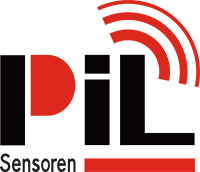Measuring with ultrasonics
Operating principle
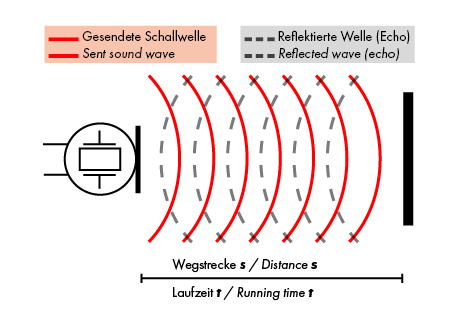
Ultrasonic sensors work on the basis of sound transmission in different media. The speed of sound, attenuation, reflection and diffusion vary greatly depending on the medium. They must be taken into account for precise and reliable measurements. Devices from PiL Sensoren GmbH are based on the principle of time of flight measurement of ultrasound in the air. The sensors operate with an ultrasonic transducer that is used to send and receive coded ultrasonic signals. When these transmitted sound waves hit an object, they are reflected and return to the ultrasonic transducer. The sensor compares the time it takes for the sound waves to return to the sensor (time of flight measurement). Using the known speed of sound in air (approx. 343 m/s at 20°C), the distance to the object can be determined. The measurement result is output as a distance-proportional, analogue or digital output signal.
Detection and measuring range
The measuring range of an ultrasonic sensor is very dependent on the measuring rate (sampling rate) and the distance to be measured. The measuring range begins at the end of the blind zone and is limited by the maximum range. The maximum range is the distance at which a sufficient ultrasonic signal can still be received by the ultrasonic transducer. The next ultrasonic pulse can only be emitted once the emitted ultrasonic pulse has completely stopped. Ultrasonic sensors with a long range therefore have small measuring rates, while ultrasonic sensors with small measuring ranges have larger measuring rates.
Measuring rate (sampling rate)

The measurement rate of an ultrasonic sensor indicates how often the sensor measures per second. It is specified in Hertz (Hz). A high measurement rate provides a better response time and faster updating of the measured values. Ideal for dynamic applications where objects move quickly. The range is limited by a high sampling rate to measuring ranges of up to approx. 2 metres. A low measuring rate increases the range of the sensor to up to 10 metres and is suitable for static or slow-moving applications.
Sound beam and opening angle
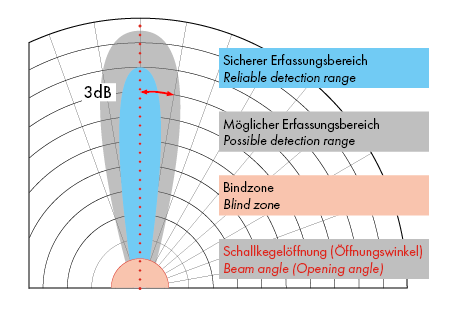
The beam angle of the sound beam indicates the 3 dB limit and significantly influences the application possibilities and performance of the sensor. At close ranges, objects outside this beam angle can also be detected. At maximum distance, the object must be positioned exactly on the sound axis. Objects that are not to be detected must therefore be as far as possible outside the sound beam. If this is not possible, sound-absorbing materials or baffles can help. The use of deflectors with focussing reflectors also helps to narrow the sound beam. A smaller beam angle enables more precise and far-reaching measurements, but in a more limited range.
Blind zone
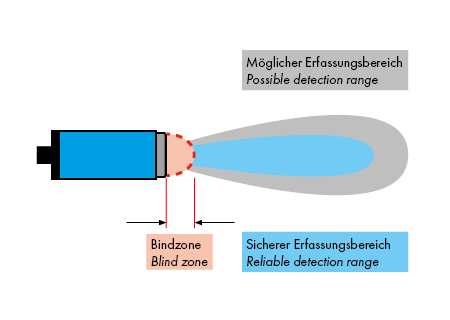
The blind zone of ultrasonic sensors refers to the zone between 30 and 800 mm directly in front of the sensor in which the sensor cannot perform precise signal readings. The blind zone is caused by the physical properties of the ultrasonic signal and the time it takes for the signal to spread out and return to the sensor. In the blind zone, the distance is so short that the sensor cannot distinguish between the transmitted and reflected signal. The exact size of the blind zone is specified in the data sheets of the respective sensor and must be taken into account when using the ultrasonic sensors in order to ensure precise and error-free measurements.
Repeatability
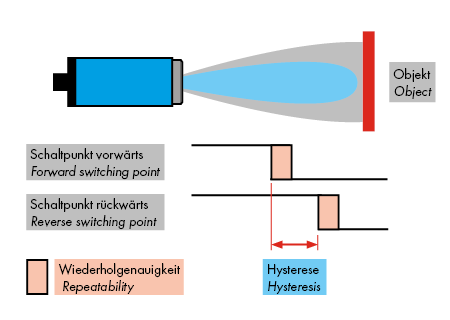
All information on repeatability and hysteresis refers to axial object movements. If an object moves closer to the sensor from a greater distance, the output switches at the set target value ± the specified repeatability. If the object moves away from the sensor, the output switches back to its original state. This occurs at a distance equal to the sum of the set setpoint value and the specified hysteresis ± the repeatability. If an object moves laterally into the sound beam, the echo strength increases. When the sensor's measuring threshold is reached, the output is activated. This position depends on the characteristics of the object and its distance from the sensor. It can only be determined experimentally.

